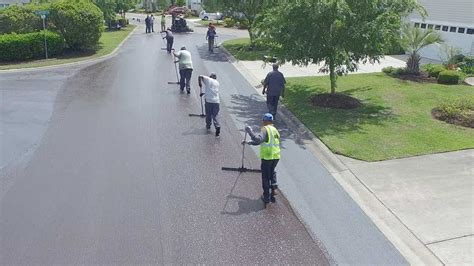Sealcoating: When Can I Return to Normal Activity?
Sealcoating your asphalt driveway or parking lot is a worthwhile investment, protecting it from the elements and extending its lifespan. However, after the application, you're left wondering: when can I resume normal activities? The answer isn't a simple one-size-fits-all, as it depends on several factors. This comprehensive guide will clarify the timeframe and precautions needed to ensure the longevity of your newly sealed surface.
How Long Does Sealcoating Take to Cure?
The curing time for sealcoating depends primarily on the type of sealant used, weather conditions (temperature, humidity, and rainfall), and the thickness of the application. Generally, most sealcoat manufacturers recommend a minimum of 24 hours of dry time before any vehicle traffic is allowed. However, full curing can take anywhere from 24 to 72 hours, or even longer in unfavorable weather.
Factors Affecting Curing Time:
- Temperature: Warmer temperatures (ideally between 50°F and 80°F) accelerate the curing process. Colder temperatures significantly slow it down.
- Humidity: High humidity can prolong the drying time as the sealant needs time to evaporate properly.
- Rainfall: Rain will obviously interrupt the curing process and may even wash away the sealant if it's not fully cured. Delaying sealcoating until a period of consistently dry weather is crucial.
- Sealant Type: Different sealants have varying drying times. Always check the manufacturer's instructions for specific recommendations.
- Thickness of Application: Thicker applications will naturally take longer to dry than thinner ones.
What Activities Should I Avoid After Sealcoating?
Until the sealcoating is fully cured, several activities should be avoided to prevent damage or premature wear:
- Driving or Parking Vehicles: This is the most crucial restriction. Driving on freshly sealed asphalt can cause tire marks, embed gravel, and damage the sealant's integrity.
- Heavy Equipment Usage: Avoid using heavy machinery like lawnmowers, snow blowers, or other equipment that could put pressure on the still-soft sealant.
- Washing the Area: Power washing or even hosing down the freshly sealed surface can wash away the sealant before it's had a chance to fully bond.
- Applying Other Products: Avoid applying any other substances, such as de-icers, until the sealcoating is fully cured.
When Can I Drive on My Newly Sealcoated Driveway?
As mentioned, a minimum of 24 hours is generally recommended before allowing any vehicle traffic. However, it's best to err on the side of caution and wait for at least 48 hours, or even longer if the weather has been unfavorable. The sealant should be firm to the touch and not easily smudged before you allow vehicle traffic. Check the manufacturer's instructions for the specific sealant used to confirm the recommended waiting period.
Can I Walk on My Newly Sealcoated Driveway?
Light foot traffic is usually permissible after 24 hours, but heavy foot traffic should be avoided until the sealant is fully cured. It's still recommended to minimize walking on the surface until the 48-72 hour mark.
What Happens if I Drive on it Too Soon?
Driving on freshly sealed asphalt before it's fully cured can lead to several problems:
- Tire Marks: Your tires can leave permanent indentations or streaks in the still-soft sealant.
- Gravel Embedding: Gravel or small stones can become embedded in the sealant, creating an uneven surface.
- Premature Wear: The sealant may not bond properly, leading to quicker wear and tear.
- Sealant Removal: In extreme cases, driving too soon could completely remove portions of the sealant.
By following these guidelines and understanding the factors influencing curing time, you can ensure your sealcoating job lasts as long as possible and protects your investment for years to come. Remember: patience is key!
Disclaimer: This information is for general guidance only. Always consult the specific instructions provided by your sealcoating manufacturer for the most accurate and relevant recommendations.

